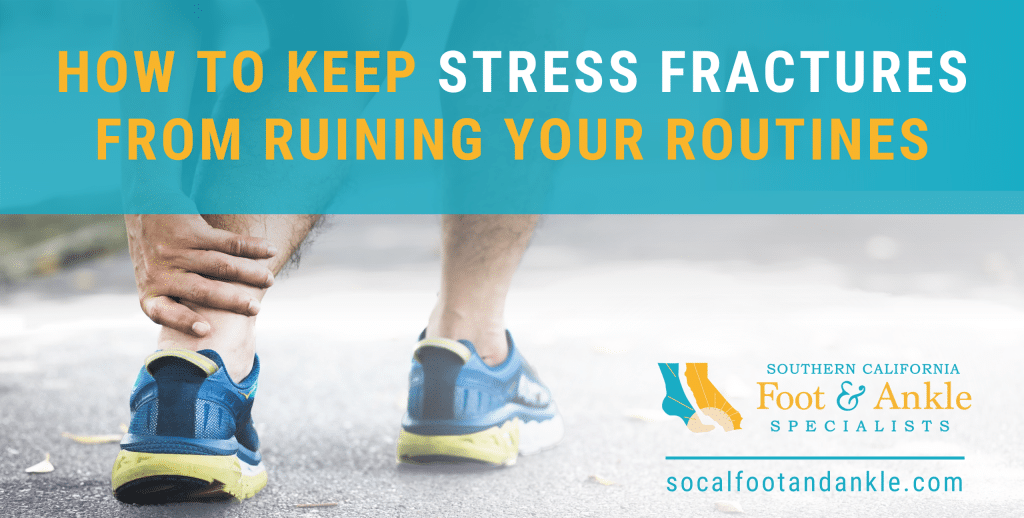How to Keep Stress Fractures from Ruining Your Routines
Everyone knows that a standard fracture can put a quick stop to just about any show, and it is rarely something you can avoid. Nobody ever expects taking a hit forceful enough to cause a bone to break.
That said, there is a type of fracture that can also cause plenty of trouble, but tends to develop more slowly than a complete fracture. Fortunately, it can also be much more preventable.
A stress fracture is a sports injury that needs effective treatment when discovered, and the right attention to keep from happening in the first place. Whether you are a committed athlete or someone who faces routine foot and ankle stresses as part of work or life, we can help you with both recovery and prevention.
What is a Stress Fracture?
When you imagine a fracture, you most likely see a complete break with the bone in two pieces. A stress fracture is different.
In a stress fracture, the break happens along the surface of the bone instead of through it. Think of it like a crack along the surface of a frozen pond. The ice has not shattered all the way through, but there is some very clear weakness and trouble going on.
A stress fracture is classified as an overuse injury, meaning that its cause tends to lie in the body experiencing too much force than it is conditioned to sustain. This can happen either by pushing the body too hard all at once (such as taking off in a heavy sprint from a dead stop) or by sustained, repetitive impacts over time.
In the case of stress fractures, repetitive stress tends to be the culprit more often than a sudden spike in strain.
The repetition of the feet striking the ground—especially in running, soccer, basketball, and any other pastime that demands a lot of movement—will weaken the bones as they take a beating. This in itself is perfectly natural. In normal conditions, it is even a good thing: our bodies will recover from this micro-trauma and come out stronger and more ready to handle the demands we place on them!
However, our bodies require rest in order to rebuild. If we do not provide enough rest and fill all our time with stresses instead, our bones will wear down faster than they can recover. Eventually, stress fractures can result.
How Do I Know I Have a Stress Fracture?
The symptoms of a stress fracture can develop gradually over time, and can be relatively easy to ignore at the onset. You might experience a bit of pain while running, for example, but it goes away after you’re done.
As stress fractures further develop, though, the pain will tend to become worse and longer lasting. Particular places where you are more likely to experience tenderness are along the heel and ball of the foot—places that tend to strike the ground during running.
Symptoms can have slight variations, but may include:
- Light swelling on top of the foot or ankle.
- Pain that feels “deep” inside.
- Tenderness and pain when a certain spot is touched.
- A feeling of weakness in the affected area.
A stress fracture might not always show up on imaging tests right when you start feeling symptoms. If you go into urgent care or a primary care physician for testing and they do not see signs of a stress fracture, it does not necessarily mean you do not have one. In some cases, it may take 10-14 days from when you start feeling pain for a stress fracture to start being visible on X-rays.
How Are Stress Fractures Treated?
You may not like the first step for treating a stress fracture, but it is certainly the most important: you need to take weight and force away from the affected area to allow it a better chance to heal.
Yes, this may very much mean suspending your current workout routine or sports for an amount of time. However, that hiatus is much better than the time you may face if you allow a stress fracture to grow worse and keep cracking the surface of a bone. Eventually, the cracks in that frozen pond can run all the way through.
It is also important that you are evaluated regarding the severity of the stress fracture. In some cases, we may recommend the use of equipment such as a walking boot, brace, or crutches to further keep weight off the affected area.
Since the feet are farthest from the heart, circulation to the area is not the best. That can make injuries such as stress fractures take longer to heal, and why patience is paramount.
That said, we also understand how this can interfere with fitness and activity goals, and want to help you remain moving as much as possible. When appropriate, we can help you find alternative, lower-impact forms of exercise you can perform during your recovery period.
How Do I Prevent Stress Fractures from Happening?
If you want to avoid stress fractures, the best methods are to be reasonable in the way you increase your workout demands and provide rest days to allow your body time to recover. It’s really that simple.
Never increase your weekly activity load more than 10 percent per week, and if things start to feel too strained or hurt, dial it down even below 10 percent. Make gains, but make them patiently.
Rest days should happen at least 2 days per week. That does not mean you have to do nothing on those days, but you should have a significantly reduced routine or cross-train to focus on other areas of the body instead.
If you have a structural abnormality in your foot that places excess pressure on a certain area, we may also recommend changes in footwear or the use of custom orthotics to distribute weight more evenly.
Don’t Crack – Get the Care You Need
If you are experiencing consistent foot or ankle pain during or after running—or anytime else for that matter—do not wait to take action. The sooner a problem is addressed, the sooner you can get back to comfort and keep the problem from growing worse.
Schedule an appointment by calling our Ladera Ranch office at (949) 364-9255 (WALK) or by filling out our online contact form.


